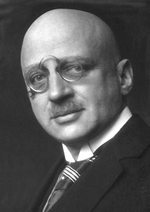
Back Haber-proses Afrikaans عملية هابر-بوش Arabic Процес на Хабер-Бош Bulgarian হেবার প্রণালী Bengali/Bangla Procés de Haber-Bosch Catalan شێوازی ھابەر CKB Haberův–Boschův proces Czech Haber-Bosch-processen Danish Haber-Bosch-Verfahren German Μέθοδος Χάμπερ-Μπος Greek
This article's lead section may be too short to adequately summarize the key points. (November 2023) |

The Haber process,[1] also called the Haber–Bosch process, is the main industrial procedure for the production of ammonia.[2][3] The German chemists Fritz Haber and Carl Bosch developed it in the first decade of the 20th century. The process converts atmospheric nitrogen (N2) to ammonia (NH3) by a reaction with hydrogen (H2) using an iron metal catalyst under high temperatures and pressures. This reaction is slightly exothermic (i.e. it releases energy), meaning that the reaction is favoured at lower temperatures[4] and higher pressures.[5] It decreases entropy, complicating the process. Hydrogen is produced via steam reforming, followed by an iterative closed cycle to react hydrogen with nitrogen to produce ammonia.
The primary reaction is:
Before the development of the Haber process, it had been difficult to produce ammonia on an industrial scale,[6][7][8] because earlier methods, such as the Birkeland–Eyde process and the Frank–Caro process, were too inefficient.
- ^ Habers process chemistry. India: Arihant publications. 2018. p. 264. ISBN 978-93-131-6303-9.
- ^ Appl, M. (1982). "The Haber–Bosch Process and the Development of Chemical Engineering". A Century of Chemical Engineering. New York: Plenum Press. pp. 29–54. ISBN 978-0-306-40895-3.
- ^ Appl, Max (2006). "Ammonia". Ullmann's Encyclopedia of Industrial Chemistry. Weinheim: Wiley-VCH. doi:10.1002/14356007.a02_143.pub2. ISBN 978-3527306732.
- ^ Clark 2013, "The forward reaction (the production of ammonia) is exothermic. According to Le Chatelier's Principle, this will be favoured at a lower temperature. The system will respond by moving the position of equilibrium to counteract this – in other words by producing more heat. To obtain as much ammonia as possible in the equilibrium mixture, as low a temperature as possible is needed".
- ^ Clark 2013, "Notice that there are 4 molecules on the left-hand side of the equation, but only 2 on the right. According to Le Chatelier's Principle, by increasing the pressure the system will respond by favouring the reaction which produces fewer molecules. That will cause the pressure to fall again. To get as much ammonia as possible in the equilibrium mixture, as high a pressure as possible is needed. 200 atmospheres is a high pressure, but not amazingly high".
- ^ Smil, Vaclav (2004). Enriching the Earth: Fritz Haber, Carl Bosch, and the Transformation of World Food Production (1st ed.). Cambridge, MA: MIT. ISBN 978-0-262-69313-4.
- ^ Hager, Thomas (2008). The Alchemy of Air: A Jewish genius, a doomed tycoon, and the scientific discovery that fed the world but fueled the rise of Hitler (1st ed.). New York, New York: Harmony Books. ISBN 978-0-307-35178-4.
- ^ Sittig, Marshall (1979). Fertilizer Industry: Processes, Pollution Control, and Energy Conservation. Park Ridge, New Jersey: Noyes Data Corp. ISBN 978-0-8155-0734-5.
© MMXXIII Rich X Search. We shall prevail. All rights reserved. Rich X Search
